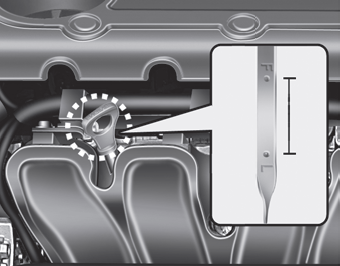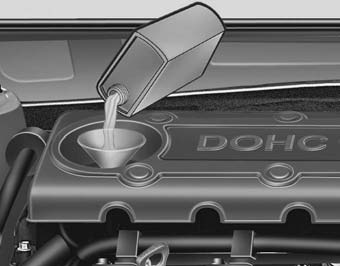Engine oil

Checking the engine oil level
1. Be sure the vehicle is on level ground.
2. Start the engine and allow it to reach normal operating temperature.
3. Turn the engine off and wait for a few minutes (about 5 minutes) for the oil to return to the oil pan.
4. Pull the dipstick out, wipe it clean, and re-insert it fully.
WARNING:
- Radiator hose Be very careful not to touch the radiator hose when checking or adding the engine oil as it may be hot enough to burn you.
5. Pull the dipstick out again and check the level. The level should be between F and L.
CAUTION:
Do not overfill with engine oil.
Engine damage may result.

If it is near or at L, add enough oil to bring the level to F. Do not overfill.
Use a funnel to help prevent oil from being spilled on engine components.
Use only the specified engine oil. (Refer to ÔÇťRecommended lubricants and capacitiesÔÇŁ in section 8.)
Changing the engine oil and filter
Have engine oil and filter changed by an authorized KIA dealer according to the Maintenance Schedule at the beginning of this section.
WARNING:
Used engine oil may cause irritation
or cancer of the skin if left in
contact with the skin for prolonged
periods of time. Used engine oil
contains chemicals that have
caused cancer in laboratory animals.
Always protect your skin by washing your hands thoroughly with soap and warm water as soon as possible after handling used oil.
See also:
The new Kia Soul begs one big question: Is this thing cool?
The Soul is a five-door hatch about a half-foot shorter than a Scion xB, one
of the youth-market vehicles that likely inspired Kia to enter this niche (the
Honda Element is another; ditto the Niss ...
CONCLUSION
My favorite Soul was the ÔÇť!ÔÇŁ trim, only available in cream white, navy blue,
silver, or black. Its two-tone beige and black dash may not suit everyoneÔÇÖs
tastes, nor will its houndstooth-patt ...
Vehicle weight
loading of your vehicle, to keep your
loaded vehicle weight within its design
rating capability. Properly loading your
vehicle will provide maximum return of
the vehicle design performance. Before ...


